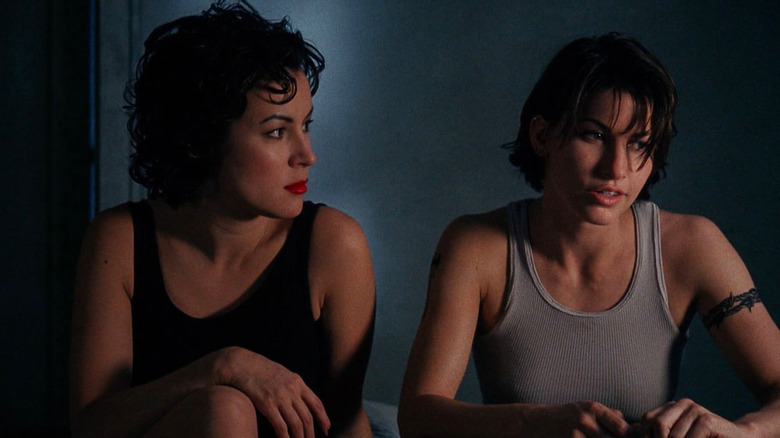The Daily Stream: Bound Introduced Filmgoers To The Wachowskis With Style
(Welcome to The Daily Stream, an ongoing series in which the /Film team shares what they've been watching, why it's worth checking out, and where you can stream it.)
The Movie: Bound
Where You Can Stream It: Hulu, Paramount+
The Pitch: Before The Wachowskis broke everyone's brains and reinvented the action blockbuster with "The Matrix," they launched their directorial career with "Bound," a 1996 indie that's sexy and stylish, and still holds up to this day. A bit of pulpy noir mixed with some Coen Brothers/Billy Wilder-influenced dark comedy mayhem, "Bound" follows two seemingly polar opposites – ex-con Corky (Gina Gershon) and gangster's girlfriend Violet (Jennifer Tilly). The two women catch each other's eye one day and before you know it, they've jumped into bed together. But then Violet takes the relationship somewhere different when she pitches a scheme to her new lover: what if they ripped off the mob? What's the worst that could happen?
Why It's Essential Viewing
"The Matrix Resurrections" will arrive this year, bringing audiences the latest head-trip from filmmaker Lana Wachowski. But before the first "The Matrix" there was "Bound," a film that appears to have its own fun little easter egg in "Matrix Resurrections." While everyone knows "The Matrix," I don't know how many people are fully aware of "Bound," the feature debut from the Wachowskis. I'm not saying "Bound" is some obscure work of art that has only been whispered about. I just don't know how popular it is these days, and it feels so far removed from the weird, bright worlds of other Wachowski films like "Speed Racer" and "Cloud Atlas."
But while "Bound" may be smaller in scale and scope, it's still bustling with style. The opening credits alone, in which the title BOUND casts a long, ominous shadow, are more stylish than most movies these days. "Bound" also doesn't mess around: it drops us into its story and quickly starts laying things out. Ex-con Corky gets a gig as a janitor at an apartment building. In this apartment building live mobster Caesar (Joe Pantoliano, who would reunite with The Wachowskis for "The Matrix") and his girlfriend Violet. Violet and Corky lock eyes in the elevator one day, and the sparks fly. Sure enough, the women are soon in the midst of an affair. And, in true noir fashion, the mobster's girlfriend has a scheme: she wants Corky to help her rip off Caesar and the mob.
A more cynical movie might've had Violet simply using Corky to do her dirty work, similar to the way Kathleen Turner ropes horny idiot William Hurt into incriminating himself in "Body Heat." But that's not what's happening here. Corky and Violet are actually attracted to each other, and by the time the credits roll, it seems like they're in love – and ready for their next dangerous caper. Until we get to that point, though, the Wachowskis craft an incredibly tense thriller. Corky and Violet's plan seems so simple it might just work. And of course, it doesn't. Everything that can go wrong does go wrong, and now the women have to think fast and act quickly, or else they're going to end up dead. This all results in a film that's thrilling, funny, queer, and unapologetically sexy as hell. In short, it rocks. And it keeps you guessing.
"We sort of made it for people who are kind of like us who go to the movies a lot and are generally kind of bored by movies today," Lana Wachowski said of "Bound," adding:
"We tried to make a movie that was entertaining, that had sex and violence because we like sex and violence. And that had a lot of deeper intellectual concepts. The whole idea of playing in a genre that is so convention heavy as film noir. It's like you almost have this dialogue with your audience because they know the conventions and you know they know the conventions. You show them something and they say I know what that is and then you start to twist it and that becomes fun because with a genre like film noir, everyone has these assumptions and expectations. And once all of those things are in place, that's when you can really start to twist it about and mess around with it. And with Bound, what we really wanted to do on another level was pull at the conventions. Because you begin to wonder why we have these conventions. Why do these stereotypes exist? What are stereotypes and where do they come from? You use that as the subtext."
